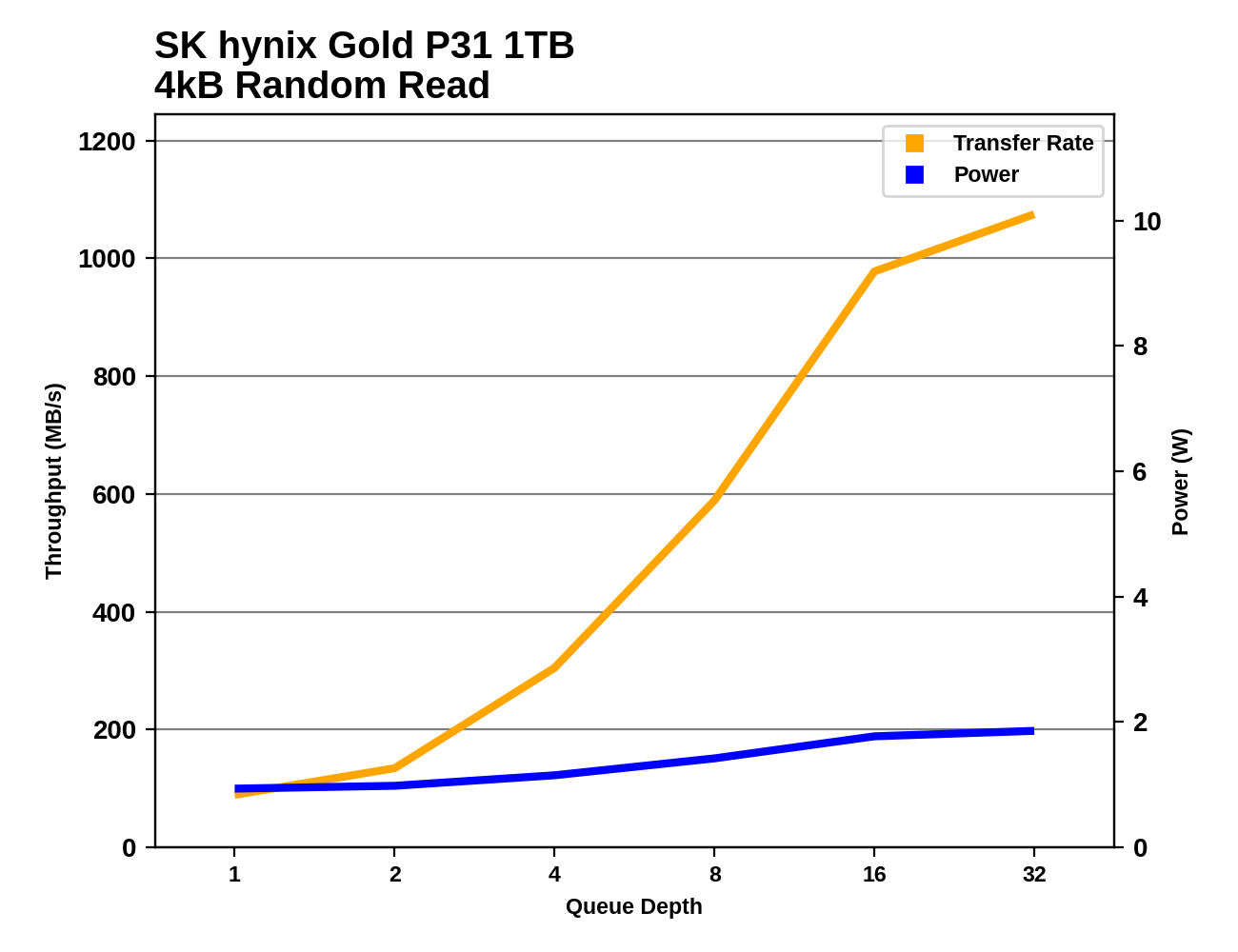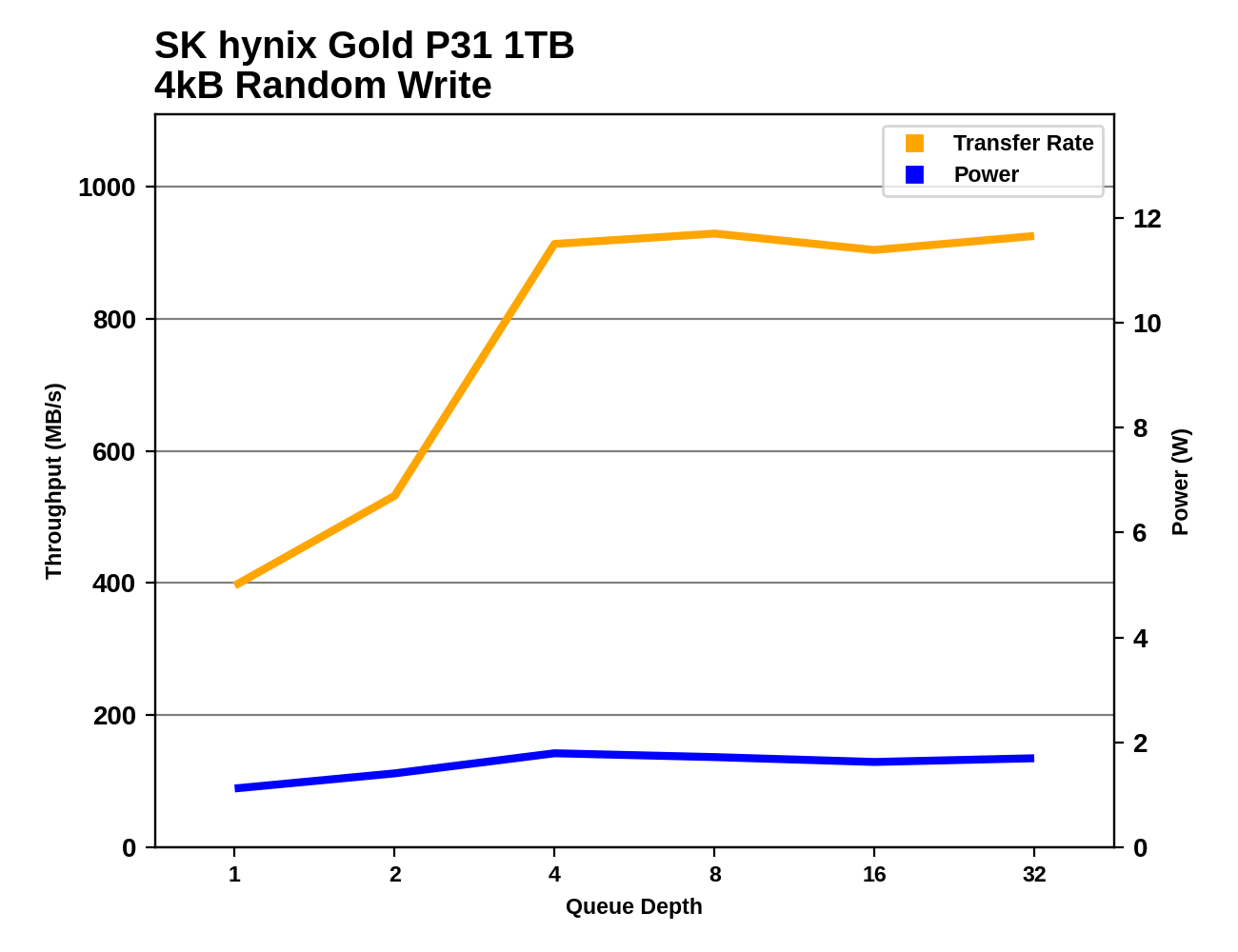The Best NVMe SSD for Laptops and Notebooks: SK hynix Gold P31 1TB SSD Reviewed
by Billy Tallis on August 27, 2020 8:00 AM ESTRandom Read Performance
Our first test of random read performance uses very short bursts of operations issued one at a time with no queuing. The drives are given enough idle time between bursts to yield an overall duty cycle of 20%, so thermal throttling is impossible. Each burst consists of a total of 32MB of 4kB random reads, from a 16GB span of the disk. The total data read is 1GB.

The QD1 burst random read performance of the SK hynix Gold P31 is similar to what we see from drives using the Silicon Motion SM2262EN controller, which has dominated this test since it hit the market.
Our sustained random read performance is similar to the random read test from our 2015 test suite: queue depths from 1 to 32 are tested, and the average performance and power efficiency across QD1, QD2 and QD4 are reported as the primary scores. Each queue depth is tested for one minute or 32GB of data transferred, whichever is shorter. After each queue depth is tested, the drive is given up to one minute to cool off so that the higher queue depths are unlikely to be affected by accumulated heat build-up. The individual read operations are again 4kB, and cover a 64GB span of the drive.

On the longer random read test that reaches into higher queue depths, the Gold P31 pulls narrowly ahead of the SX8200 Pro to set a new record for TLC-based SSDs.
 |
|||||||||
| Power Efficiency in MB/s/W | Average Power in W | ||||||||
The power draw of the Gold P31 is only a hair above that of its SATA sibling, the Gold S31. But the P31 is delivering almost three times the performance of that drive, and twice the performance per Watt of the next most efficient drive.
 |
|||||||||
The Gold P31 delivers class-leading performance across the entire range of queue depths covered by this test. Its performance is starting to taper off by QD32, but at that point it has caught up with the throughput of the Optane 905P. The widest margins over other TLC SSDs are around QD8 through QD16. Power consumption remains very low throughout the test, not even reaching 2W at QD32 - that 2x efficiency advantage over the competition remains just as true at high queue depths.
Plotting the P31's results against the entire benchmark database shows that the P31 stakes out new territory. The closest competition on the power/performance landscape are the tiny Intel Optane Memory M.2 drives, and at QD4 or higher all the other flash-based SSDs need considerably more power to deliver the same performance (at QD4 and below, the P31 is still in SATA performance territory where there are more low-power competitors).
Random Write Performance
Our test of random write burst performance is structured similarly to the random read burst test, but each burst is only 4MB and the total test length is 128MB. The 4kB random write operations are distributed over a 16GB span of the drive, and the operations are issued one at a time with no queuing.

The burst random write performance of the Gold P31 is lackluster: slower than most high-end NVMe drives, though actually still a bit faster than the Samsung 970 EVO Plus.
As with the sustained random read test, our sustained 4kB random write test runs for up to one minute or 32GB per queue depth, covering a 64GB span of the drive and giving the drive up to 1 minute of idle time between queue depths to allow for write caches to be flushed and for the drive to cool down.

On the longer random write test that includes some higher queue depths, the high-end NVMe drives mostly have fairly similar scores, and the P31 falls in the middle of the pack for performance.
 |
|||||||||
| Power Efficiency in MB/s/W | Average Power in W | ||||||||
Once again, the power consumption of the Gold P31 is more in line with low-power SATA or DRAMless NVMe drives, even though it offers high-end performance. This time, the efficiency score isn't quite twice that of the next best competitor, but a 75% improvement is still impressive.
 |
|||||||||
The performance profile for the Gold P31 on the random write test is fairly typical: fill performance is reached at QD4, and performance is mostly steady through the rest of the test. The P31 starts out slightly slower at QD1, but at full speed it is definitely competitive.
Comparing the Gold P31's random write performance against our entire database of results shows it standing out even more clearly than it did for the random read results. The QD1 random write performance is already beyond the reach of SATA drives, and none of the other NVMe drives we've tested operate at such low power levels.












80 Comments
View All Comments
vladx - Thursday, August 27, 2020 - link
I have a SX8200 Pro on my laptop, do I need to enable the laptop Power Management state or is it detected automatically by the firmware?Billy Tallis - Thursday, August 27, 2020 - link
That really depends on what combination of firmware and driver bugs the laptop vendor gave you. But in theory, if the machine originally came with a M.2 NVMe drive, it should have been configured for proper power management and should continue to work well with an aftermarket SSD that doesn't bring any new power management bugs. I think the SX8200 Pro is okay on that score; the slow wake-up times shouldn't prevent the system from trying to use the deep idle states because the drive still promises the OS that it will have reasonable wake-up times.vladx - Thursday, August 27, 2020 - link
My laptop is a MSI Creator 17 that came with a Samsung PM981 drive. Could HWinfo offer any help in identifying the active power states?Billy Tallis - Thursday, August 27, 2020 - link
I'm not sure. I think you can figure out what PCIe power management settings are being used by digging through the PCI configuration space, but I'm not sure how easy it is to get that info while running Windows. As for the NVMe power management settings, my understanding is that it's impossible or very nearly impossible to access that information under Windows, at least with the usual NVMe drivers. The only reliable way I know of to confirm that everything is working correctly to get your SSD idling below 10mW is to have expensive power measurement equipment.vladx - Thursday, August 27, 2020 - link
Ok thanks, Billy. I was going to install Fedora anyways as secondary OS so I guess I'll try the Linux route then.MrCommunistGen - Thursday, August 27, 2020 - link
vladx, I'm really interested in how you go about trying to tease the NVMe power management info out of the drive. I did some internet searches a while back and didn't find anything definitive that I was able to follow and get results from. I've only ever used Debian-based distros, but if you're able to figure it out in Fedora then at least I'll know it is possible.Foeketijn - Thursday, August 27, 2020 - link
Did it happen? Did Samsung finally get an actual competitor? It doesn't really beat the 970 evo that much, so the 970 pro would still be better, but not at this price point, and definitely not with this power usage.Last time intel did that, Samsung suddenly woke up and beat them down again to a place where they stayed since.
Interesting to see what the new evo and pro line will bring.
Not high margin prices this time arround I guess.
LarsBolender - Thursday, August 27, 2020 - link
This has to be one of the most positive AnandTech articles I have read in years. Good job SK Hynix!Luminar - Thursday, August 27, 2020 - link
No recommendation sticker, though.Zan Lynx - Thursday, August 27, 2020 - link
It would be handy if you could add a power loss consistency test. I have a Dell with an older hynix NVMe and one time the battery ran down in the bag, and on reboot its btrfs was corrupt.Imagine these are sequence numbers in metadata blocks.
Correct: 10 12 22 30
Actual: 10 12 11 30
The hynix had committed writes for SOME of the blocks but a few in the middle of the update chain were old versions of the data. According to btrfs flush rules that is un-possible. Which means that the drive reported a successful write for 22 and for 30 but after powerloss recovery it lost that write for 22 and reverted to an older block.
I mean, that's better than some of the older flash drives that would trash the entire FTL and lose all the data. But it is not exactly GOOD.
I'm pretty sure Samsung consumer drives will also lose the data but at least they will revert all of the writes following the lost data, so in my example it would revert write 30 also. That would at least leave things in a logically consistent state.